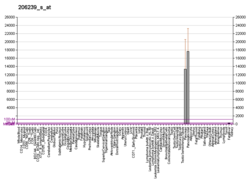Pancreatic secretory trypsin inhibitor (PSTI) also known as serine protease inhibitor Kazal-type 1 (SPINK1) or tumor-associated trypsin inhibitor (TATI) is a protein that in humans is encoded by the SPINK1 gene.[5]
Mutations in SPINK1 has been associated with hereditary pancreatitis and tropical pancreatitis. Trypsinogen is normally created and stored an inactive zymogen of trypsin in the pancreas, but occasionally will autoactivate itself. PSTI serves to cleave prematurely activated trypsin to prevent the enzyme from causing cellular damage to the organ. Without the function of PSTI, the pancreas is subject to repeated episodes of damage.[6]
It has also been associated with prostate cancer.[7]
See also
editReferences
edit- ^ a b c GRCh38: Ensembl release 89: ENSG00000164266 – Ensembl, May 2017
- ^ a b c GRCm38: Ensembl release 89: ENSMUSG00000024503 – Ensembl, May 2017
- ^ "Human PubMed Reference:". National Center for Biotechnology Information, U.S. National Library of Medicine.
- ^ "Mouse PubMed Reference:". National Center for Biotechnology Information, U.S. National Library of Medicine.
- ^ "Entrez Gene: SPINK1 serine peptidase inhibitor, Kazal type 1".
- ^ Schneider, A. "SPINK1 - serine peptidase inhibitor, Kazal type 1". Wikigenes.
- ^ Tomlins SA, Rhodes DR, Yu J, Varambally S, Mehra R, Perner S, et al. (Jun 2008). "The role of SPINK1 in ETS rearrangement-negative prostate cancers". Cancer Cell. 13 (6): 519–28. doi:10.1016/j.ccr.2008.04.016. PMC 2732022. PMID 18538735.
Further reading
edit- Marchbank T, Freeman TC, Playford RJ (1998). "Human pancreatic secretory trypsin inhibitor. Distribution, actions and possible role in mucosal integrity and repair". Digestion. 59 (3): 167–74. doi:10.1159/000007485. PMID 9643675.
- Pfützer RH, Whitcomb DC (2002). "SPINK1 mutations are associated with multiple phenotypes". Pancreatology. 1 (5): 457–60. doi:10.1159/000055847. PMID 12120224. S2CID 8123648.
- Schneider A (Mar 2005). "Serine protease inhibitor kazal type 1 mutations and pancreatitis". Clinics in Laboratory Medicine. 25 (1): 61–78. doi:10.1016/j.cll.2004.12.005. PMID 15749232.
- Cohn JA, Mitchell RM, Jowell PS (Mar 2005). "The impact of cystic fibrosis and PSTI/SPINK1 gene mutations on susceptibility to chronic pancreatitis". Clinics in Laboratory Medicine. 25 (1): 79–100. doi:10.1016/j.cll.2004.12.007. PMID 15749233.
- Kandula L, Whitcomb DC, Lowe ME (Jun 2006). "Genetic issues in pediatric pancreatitis". Current Gastroenterology Reports. 8 (3): 248–53. doi:10.1007/s11894-006-0083-8. PMID 16764792. S2CID 23606613.
- Bartelt DC, Shapanka R, Greene LJ (Feb 1977). "The primary structure of the human pancreatic secretory trypsin inhibitor. Amino acid sequence of the reduced S-aminoethylated protein". Archives of Biochemistry and Biophysics. 179 (1): 189–99. doi:10.1016/0003-9861(77)90103-5. PMID 843082.
- Hecht HJ, Szardenings M, Collins J, Schomburg D (Jun 1992). "Three-dimensional structure of a recombinant variant of human pancreatic secretory trypsin inhibitor (Kazal type)". Journal of Molecular Biology. 225 (4): 1095–103. doi:10.1016/0022-2836(92)90107-U. PMID 1613792.
- Hecht HJ, Szardenings M, Collins J, Schomburg D (Aug 1991). "Three-dimensional structure of the complexes between bovine chymotrypsinogen A and two recombinant variants of human pancreatic secretory trypsin inhibitor (Kazal-type)". Journal of Molecular Biology. 220 (3): 711–22. doi:10.1016/0022-2836(91)90112-J. PMID 1870127.
- Freeman TC, Davies R, Calam J (Dec 1990). "Interactions of pancreatic secretory trypsin inhibitor in small intestinal juice: its hydrolysis and protection by intraluminal factors". Clinica Chimica Acta; International Journal of Clinical Chemistry. 195 (1–2): 27–39. doi:10.1016/0009-8981(90)90191-T. PMID 2093478.
- Kido H, Yokogoshi Y, Katunuma N (Mar 1990). "A low-molecular-mass Kazal-type protease inhibitor isolated from rat hepatocytes is identical to rat pancreatic secretory trypsin inhibitor II. Purification and amino acid sequence". European Journal of Biochemistry. 188 (3): 501–6. doi:10.1111/j.1432-1033.1990.tb15428.x. PMID 2110056.
- Tomita N, Horii A, Yamamoto T, Ogawa M, Mori T, Matsubara K (Dec 1987). "Expression of pancreatic secretory trypsin inhibitor gene in neoplastic tissues". FEBS Letters. 225 (1–2): 113–9. doi:10.1016/0014-5793(87)81141-9. PMID 2961612. S2CID 20663654.
- Horii A, Kobayashi T, Tomita N, Yamamoto T, Fukushige S, Murotsu T, Ogawa M, Mori T, Matsubara K (Dec 1987). "Primary structure of human pancreatic secretory trypsin inhibitor (PSTI) gene". Biochemical and Biophysical Research Communications. 149 (2): 635–41. doi:10.1016/0006-291X(87)90415-3. PMID 3501289.
- Yamamoto T, Nakamura Y, Nishide J, Emi M, Ogawa M, Mori T, Matsubara K (Oct 1985). "Molecular cloning and nucleotide sequence of human pancreatic secretory trypsin inhibitor (PSTI) cDNA". Biochemical and Biophysical Research Communications. 132 (2): 605–12. doi:10.1016/0006-291X(85)91176-3. PMID 3877508.
- Huhtala ML, Pesonen K, Kalkkinen N, Stenman UH (Nov 1982). "Purification and characterization of a tumor-associated trypsin inhibitor from the urine of a patient with ovarian cancer". The Journal of Biological Chemistry. 257 (22): 13713–6. doi:10.1016/S0021-9258(18)33505-1. PMID 7142173.
- Klaus W, Schomburg D (Feb 1993). "Solution structure of a variant of human pancreatic secretory trypsin inhibitor determined by nuclear magnetic resonance spectroscopy". Journal of Molecular Biology. 229 (3): 695–706. doi:10.1006/jmbi.1993.1073. PMID 8433367.
- Chen JM, Mercier B, Audrezet MP, Ferec C (Jan 2000). "Mutational analysis of the human pancreatic secretory trypsin inhibitor (PSTI) gene in hereditary and sporadic chronic pancreatitis". Journal of Medical Genetics. 37 (1): 67–9. doi:10.1136/jmg.37.1.67. PMC 1734438. PMID 10691414.
- Witt H, Luck W, Hennies HC, Classen M, Kage A, Lass U, Landt O, Becker M (Jun 2000). "Mutations in the gene encoding the serine protease inhibitor, Kazal type 1 are associated with chronic pancreatitis". Nature Genetics. 25 (2): 213–6. doi:10.1038/76088. PMID 10835640. S2CID 23661289.
- Pfützer RH, Barmada MM, Brunskill AP, Finch R, Hart PS, Neoptolemos J, Furey WF, Whitcomb DC (Sep 2000). "SPINK1/PSTI polymorphisms act as disease modifiers in familial and idiopathic chronic pancreatitis". Gastroenterology. 119 (3): 615–23. doi:10.1053/gast.2000.18017. PMID 10982753.
- Kaneko K, Nagasaki Y, Furukawa T, Mizutamari H, Sato A, Masamune A, Shimosegawa T, Horii A (2001). "Analysis of the human pancreatic secretory trypsin inhibitor (PSTI) gene mutations in Japanese patients with chronic pancreatitis". Journal of Human Genetics. 46 (5): 293–7. doi:10.1007/s100380170082. PMID 11355022.





